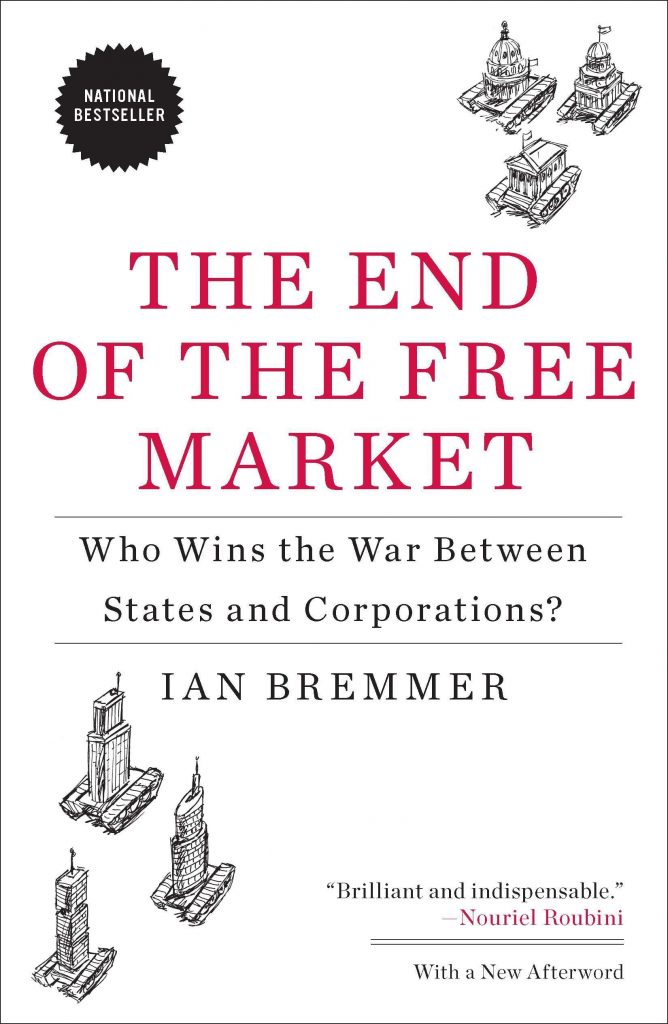The title of this book, The End of the Free Market: Who Wins the War between States and Corporations? (by Ian Bremmer, 2010, published by Penguin), could have been, “Alternatives to the Free Market”, or “Challenges to…”, or “Competitions to the Free Market”, or something along those lines. The book is organized with reference to the distinction between free market capitalism and command economy, and then he places the third approach “state capitalism” in between the two poles. State capitalism refers to an approach to economy and governance, whereby the forces of free market are supervised and harnessed by the state. The state becomes a participant (though a disproportionately strong participant) in the market. If we use the sports metaphor, the role of the state is a hybrid role between a player and a referee (or rule-maker). Aside from that general commonality, each state develops its own particular style based on its priorities and the tools at its disposals, and this prevents giving a general account of state capitalism.
In Bremmer’s book, we read about why state capitalism has emerged: national interests (e.g., with respect to natural resources), fast emerging markets (in Brazil, Russia, India, and China), having to decide what to do with the wealth of a nation, and crises (especially those originating from the United States, casting doubt on the relatively unsupervised free market). The book helps us distinguish is between different forms of state capitalism. Government regulations are driven by different motives, which could be economic (support of national products, job, and economic growth) or political (consolidating state power). In both cases, state capitalism protects something (economy or politics) and in both cases, an act of regulation/protection will necessitate more protection, more supervision, in the future. In addition to reading about China, Russia, UAE, and several other countries, we also read about the Scandinavian states and their style of regulating free market (and their dissociation between corporations and states) is useful in understanding the subject-matter of the book, and why it is presented the way it is, i.e., a challenge, and with the emphasis on the developing economies.
The book clearly presents an American perspective, and it is published 11 years ago, but despite those features the book is interesting and engaging, especially against the backdrop of what I normally read. When you read a book like this, you get a glimpse of the larger world, and of how much is going on the world, at the scale of nations and international exchange. Of course, with these topics, our view is always limited and distorted, but even a limited view of the world economy and its history can inform us about what is possible, the types of planning, the forms of organizations, and the styles of management that can arise across the world. If you’re used to thinking at the psychological scale, like me, the sheer enormity of the subject-matter makes this type of book stimulation.
Let’s end by looking at the table of content: after an introduction, the book is divided into six chapters: (1) The Rise of a New System, (2) A Brief History of Capitalism, (3) State Capitalism: What It Is and How It Happened? (4) State Capitalism Around the World, (5) The Challenge, (6) Meeting the Challenge. Chapter 4 is the longest chapter of the book, and includes detailed accounts of various countries, and I like the author’s reliance on concrete examples (as opposed to general political and economic theory). Some of his accounts were incomplete, for example in reference in Iran (which I know a little about). Namely, Bremmer blames the Islamic Republic for providing national subsidies on oil and other resources, neglecting the more significant–and much more problematic–government spendings on military conflicts outside of the country. Reading his account of Iran made me a little skeptical about the accuracy of the book with respect to other countries. In the last chapter, the challenges were framed from the perspective of a free-market advocate (or more crudely, in terms of an East-West conflict). I think the problem could be better formulated in terms of relatively better and worse styles of supervision. Some regulation and supervision of the free market is unavoidable. When we regress back into debates about free versus unfree markets, we miss the more useful and practical discussion about styles regulation, aims of regulation, and the long-term prospects of regulations.
The book was worth reading. I’d be interested in reading a more up-to-date version of this book. If you know a comparable book, written and published after 2018 (perhaps even outside of the USA), let me know.
Note: The link to the book is an Amazon affiliate link, which means I’ll receive a small commission from a qualified purchase, with no additional cost to you.
